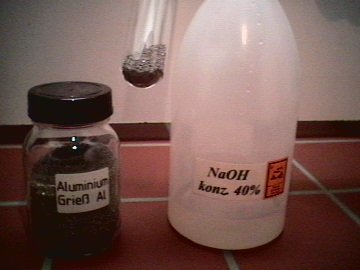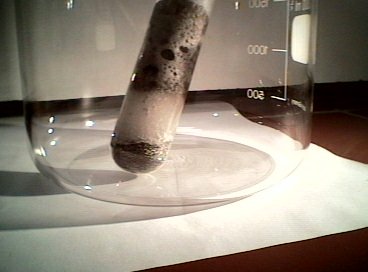



| 1. |  |
2. |  |
| Materials used | Aluminum immediately following the addition of 40 percent sodium hydroxide | ||
| 3. |  |
4. |  |
| Aluminum with 40 percent sodium hydroxide after approx. 2 minutes | View from above; end of the reaction |
| Photos 1, 2: | Experimental setup: 5 g coarse aluminum powder is combined with approx. 20 ml of 40 percent sodium hydroxide solution in a test tube. The tube is placed in a tall 2 liter glass beaker. |
| Photos 3, 4: | Shortly thereafter, a violent reaction causing gas production begins. An oxyhydrogen gas probe returns positive. Under normal circumstances, aluminum does not react with water, as an impermeable protective layer composed of aluminum hydroxide either forms within seconds or is already in place. With the addition of sodium hydroxide, the formation of a protective layer is prevented. With the production of aluminates (Al(OH)4-), the amphoteric (capable of acting as either an acid or a base) aluminum hydroxide Al(OH)3 goes in solution:
2 Al + 6 H2O > 2 Al(OH)3 + 3 H2
Al(OH)3 + NaOH > Na+ + [Al(OH)4]- A layer of aluminum oxide previously formed by passive corrosion is dissolved by the addition of sodium hydroxide. For this reason, the reaction takes place at the beginning relatively slowly: Al2O3 + 2 NaOH + 3 H2O > 2 Na+ + 2 [Al(OH)4]-
The aluminum completely dissolves and the water acts here too as an acid (for an analog, see Experiment 4.4.1). |
This reaction is used in drain cleaners. They are mostly made out of strong alkalis, to which alumunim or zinc has been added. The alkalis break down organic residues chemically. In addition, the formation of hydrogen leads to a bubbling effect which adds an additional mechanical cleaning mechanism.